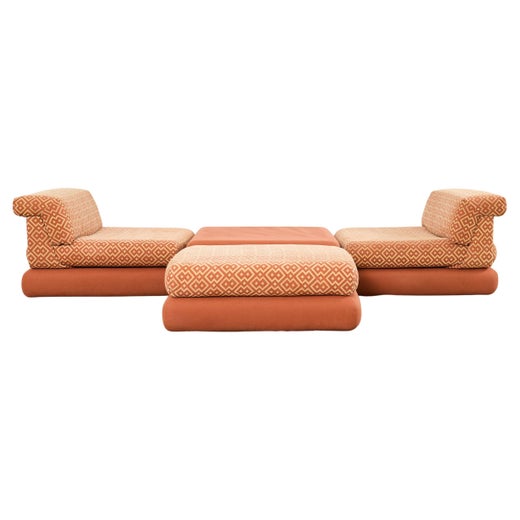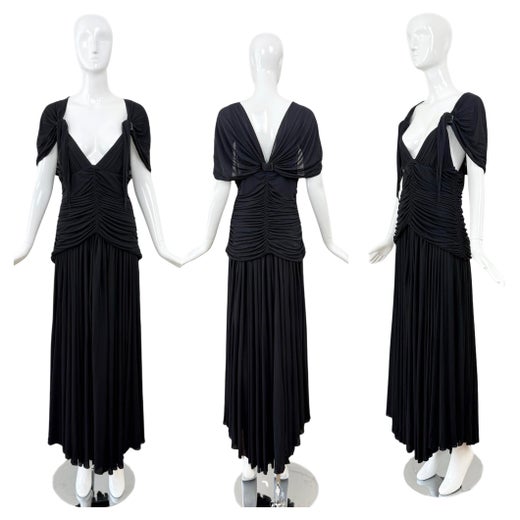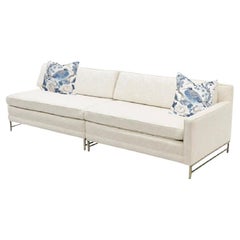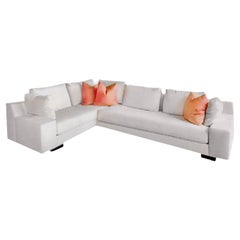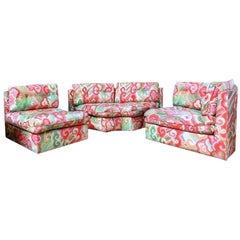Le Mah Jong Roche Bobois Modular Sofa Missoni Square Cushion Set, Teal & Orange
About the Item
- Creator:
- Dimensions:Height: 7.49 in (19 cm)Width: 37.41 in (95 cm)Depth: 37.41 in (95 cm)
- Sold As:Set of 2
- Style:Mid-Century Modern (Of the Period)
- Materials and Techniques:
- Place of Origin:
- Period:
- Date of Manufacture:2014
- Condition:Wear consistent with age and use. Good vintage condition. No apparent major condition issues of concern at time of listing.
- Seller Location:Brooklyn, NY
- Reference Number:1stDibs: LU4190316763562
Hans Hopfer
German designer and artist Hans Hopfer had a profound impact on furniture design that still guides the choices we make about our spaces today. Affectionately dubbed “seating landscapes,” Hopfer’s forward-looking collections of inviting, modular low-profile seating, such as the widely revered Mah Jong sofa for Roche Bobois, allowed for optimal customized arrangements in one’s living room, an innovation that reshaped relaxation at home in a significant and lasting way.
Hopfer designed modern furniture for a manufacturer in Nuremberg during the 1960s. He met Phillippe Roche in 1970 and began his collaboration with the Roche Bobois company. When the popularity of cable television took hold in more major American cities during the 1970s, sofas and other seating became integral to contemporary living-room decor. Roche Bobois’s newly launched Les Contemporains series positioned its own sofas front and center, and it also offered plush lounge chairs designed by Mario Bellini.
Bold works from Roche Bobois during the decade included one of its most enduring and well-known pieces — the Mah Jong sectional sofa created by Hopfer in 1971. Anchored by few central elements, this modular lounge sofa can be combined or stacked, giving the buyer total freedom over its appearance and the ability to maximize comfort with its plump cushions. Inspired by a tile-based game that originated in China, the Mah Jong has been in production since its debut. It is still handmade in a workshop in Italy today.
Composed of low seating elements and large cushions, Hopfer’s Mah Jong sofa has seen some high-profile fabric updates by Missoni, Jean Paul Gaultier and Japanese clothing designer Kenzo Takada, who worked with Roche Bobois to craft fabrics emblazoned with geometrically dynamic patterns to be used as upholstery for the firm’s iconic piece of furniture.
Primarily a sculptor and painter by trade, Hopfer worked and lived between Buenos Aires, Nuremberg and Paris. In addition to the work he did for Roche Bobois — which included his Informel armchairs and sofas — he also created modular furniture for the Wiener Werkstatte, a collective of artists and designers born from the Vienna Secession art movement in Austria during the early 20th century.
On 1stDibs, find vintage Hans Hopfer lounge chairs, armchairs and sofas.
Jean Paul Gaultier
Endeavoring to tear down gender stereotypes and sartorial norms on the catwalk, making underwear outerwear, putting men in skirts and models of all shapes and sizes on the runway, Jean Paul Gaultier has created wildly provocative, transformational designs for day dresses, gowns, tops and other garments that draw on numerous influences and boldly merge haute couture with street sensibility.
An only child raised in the suburbs of Paris, Gaultier didn’t have a formal fashion education. But he loved to sketch and was drawn to clothing, citing the corsets in his maternal grandmother’s closet as having a formative impact on his creative direction. He’s said that some of his earliest fashion work was for his teddy bear, and later he would send his sketches to designers he revered, including Pierre Cardin.
Gaultier began his career in 1970 as an assistant to Cardin, who admired the sketches the 18-year-old had sent for his appraisal. After Gaultier had his first runway show in 1976, featuring unconventional statements like pairing motorcycle jackets with ballerina skirts, it didn’t take long for his star to rise.
Gaultier's playful but exquisitely crafted reimaginings of classic Parisian styles — the striped mariner shirt, the trench coat — soon became recurring themes of his eponymous house, which he founded with his life partner and business associate Francis Menuge in 1982.
“He was absolutely peerless for the longest time in the late ’80s and early ’90s,” fashion editor Tim Blanks told the New York Times. This was the period of Gaultier’s most iconic designs.
In 1984, Gaultier’s “Boy Toy” collection challenged men’s fashion with striped shirts and skirts — and sold around 3,000 of them. He was hailed for spectacle-laden runway shows and superb tailoring. Gaultier began to work with Madonna during the late 1980s, and, at the pop star’s request, he designed the costumes for her 1990 “Blond Ambition” tour. Her pink corset became a cultural touchstone of the era.
Gaultier continued to expand his brand. There were the colorful all-over graphic prints in the sheer stretch-tulle fabric of his Soleil line — which have gained fans in millennials seeking the authentic, easy style of 1990s fashion — and he debuted his first couture collection in 1997. Gaultier created costumes for film and stage and was nominated for a César Award for Best Costume Design for The City of Lost Children (1995) and then a second for Luc Besson’s The Fifth Element (1997).
From 2003 to 2010, Gaultier was the creative director for Hermès. The first international exhibition of his work, “The Fashion World of Jean Paul Gaultier: From the Sidewalk to the Catwalk,” debuted in 2011 at the Montreal Museum of Fine Arts and toured to cities including Stockholm, New York City, Dallas and London. Vintage Gaultier Birkin bags are unsurprisingly sought-after collectibles, and the So Black collection — a line that included the So Black Birkin, which featured black PVD-coated hardware — was among his last works for the brand before his departure.
Gaultier presented his last ready-to-wear collection in 2014 and in 2020 stepped down from his couture line, ending his boundary-pushing, industry-shaping reign with a raucous show of more than 230 outfits formed from fragments of collections from across his 50-year career.
One of fashion’s enfants terribles, Gaultier has never sought out pretty for pretty’s sake. Instead, he has challenged the traditional ideals of beauty. Today, the designer's vintage clothing designs — experimental undergarments cut from lace and suede, leather-trimmed evening dresses and jackets of denim, plastic or striped jersey — are as punk as they are high fashion.
Find vintage Jean Paul Gaultier dresses, skirts, jeans and accessories today on 1stDibs.
You May Also Like
Vintage 1970s French Modern Sofas
Upholstery, Fabric
Vintage 1970s French Sofas
Fabric
21st Century and Contemporary Post-Modern Sectional Sofas
Cotton, Satin, Velvet
Late 20th Century Italian Post-Modern Sectional Sofas
Cotton, Satin, Velvet
Late 20th Century Italian Post-Modern Sectional Sofas
Cotton, Satin, Velvet
Mid-20th Century French Mid-Century Modern Sectional Sofas
Fabric
21st Century and Contemporary French Modern Sofas
Fabric
Early 2000s French Post-Modern Sofas
Fabric
21st Century and Contemporary French Mid-Century Modern Sofas
Fabric
Early 2000s French Sofas
Fabric
More From This Seller
View All21st Century and Contemporary Italian Mid-Century Modern Sectional Sofas
Silk, Velvet
Mid-20th Century American Mid-Century Modern Sectional Sofas
Brass
21st Century and Contemporary French Organic Modern Sectional Sofas
Textile
Mid-20th Century American Mid-Century Modern Sectional Sofas
Textile, Wool, Mohair
Late 20th Century American Post-Modern Sectional Sofas
Textile, Wood
Mid-20th Century Italian Mid-Century Modern Sofas
Steel
Recently Viewed
View AllRead More
How the Anglepoise Lamp Went from Desktop Companion to Hollywood Icon
Since its 1934 debut, the ingenious task light has become one of the most celebrated examples of industrial design.
You Saw It at the Met Ball. Here’s What Camp Fashion Is Really About
This year's Costume Institute exhibition is all about embracing the eccentric.
